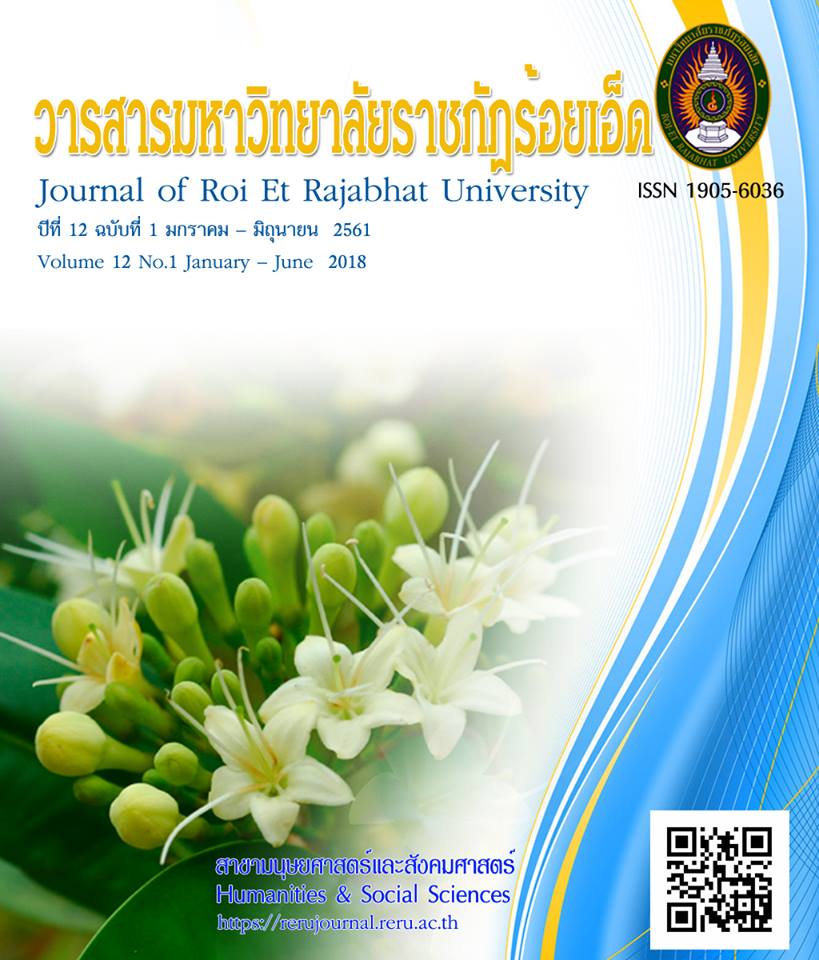Learning Styles of Roi Et Rajabhat University Students
Keywords:
Learning Style, Instructional Models, Learning TheoryAbstract
This research aimed to 1) examine learning styles of Roi Et Rajabhat University students and 2) study correlation between the students’ learning styles and the teachers’ teaching styles. The samples consisted of 736 students and 74 teachers. The research instruments were constructed questionnaires each of which investigated the students’ learning styles and the teachers’ teaching styles. Statistics used in data analysis were frequency, percentage, mean, standard deviation, Chi – Square The students used single learning styles for 71.73%, the blended learning format combining two styles for 17.90%, and three styles for 5.68%. 2) As a whole, the students' learning styles and the teachers' teaching styles were significantly correlated at a correlation coefficient of .193. Separately, only at the Faculty of Education, the students' learning styles and the teachers' teaching styles were significantly correlated at a correlation coefficient of .24. However, at other faculties or departments, the correlation between the learning styles and the teaching styles was not discovered.
References
ธัญมาส รวยรื่น. (2556). แบบการเรียนรู้ของบัณฑิตเกียรตินิยมหลักสูตรครู 5 ปี คณะศึกษาศาสตร์ มหาวิทยาลัยรามคำแหง. วิทยานิพนธ์ ศึกษาศาสตรมหาบัณฑิต สาขาวิชาการพัฒนาทรัพยากรมนุษย์. กรุงเทพฯ: มหาวิทยาลัยรามคำแหง.
วิจารณ์ พานิช. (2556). ครูเพื่อศิษย์ สนุกกับการเรียนรู้ในศตวรรษที่ 21. สานปฏิรูป ฉบับพิเศษลำดับที่ 4. มูลนิธิสดศรีสฤษดิ์วงศ์. กรุงเทพมหานคร.
สำนักงานคณะกรรมการการศึกษาแห่งชาติ. (2542). พระราชบัญญัติการศึกษาแห่งชาติ พ.ศ. 2542. กรุงเทพฯ: โรงพิมพ์องค์การ รับส่งสินค้าและพัสดุภัณฑ์.
องอาจ นัยพัฒน์. (2551). การออกแบบการวิจัย: วิธีการเชิงปริมาณ เชิงคุณภาพและผสมผสานวิธี. กรุงเทพฯ: สำนักพิมพ์ แห่งจุฬาลงกรณ์มหาวิทยาลัย.
Currie, G. (1995). Learning Theory and the Design of Training in a Health Authority. Journal of Health Manpower Management, 21(2),13-19.
Joyce, B. & Weil, M. (2010). Models of Teaching. United States of America, Prenice Hall International.
Kolb, D. (1984). Experiential Learning: Experience as the Source of Learning and Development. Englewood Cliffs, NJ: Prentice-Hall.
Krejcie,V.R. & Morgan,W.E. (1970). Sample size for Research Activities. Journal of Educational and Psychological Measurement, (30), 607-610.
Lowe, D. & Skitmore, M. (1994). Experiential Learning in Cost Estimating. Journal of Construction Management and Economics, 12, 423-431.
Robotham, (1995). Self-directed learning: the ultimate learning style. Journal of European Industrial Training, 19 (7), 3-7.
Downloads
Published
How to Cite
Issue
Section
License
บทความที่ได้รับการตีพิมพ์เป็นลิขสิทธิ์ของวารสารมหาวิทยาลัยราชภัฎร้อยเอ็ด
ข้อความที่ปรากฏในบทความแต่ละเรื่องในวารสารวิชาการเล่มนี้เป็นความคิดเห็นส่วนตัวของผู้เขียนแต่ละท่านไม่เกี่ยวข้องกับมหาวิทยาลัยราชภัฎร้อยเอ็ด และคณาจารย์ท่านอื่นๆในมหาวิทยาลัยฯ แต่อย่างใด ความรับผิดชอบองค์ประกอบทั้งหมดของบทความแต่ละเรื่องเป็นของผู้เขียนแต่ละท่าน หากมีความผิดพลาดใดๆ ผู้เขียนแต่ละท่านจะรับผิดชอบบทความของตนเองแต่ผู้เดียว





